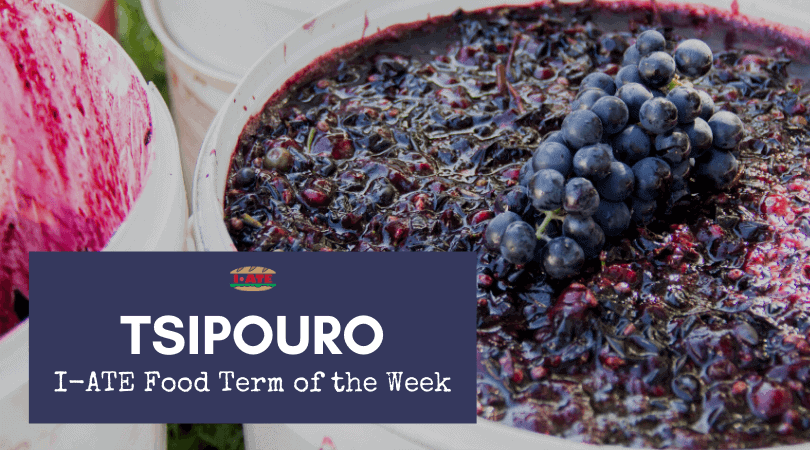 This week’s I·ATE Food Term of the Week is a – drink term! Grapes and wine are deeply rooted in Greek culture. For Greece, wine and olive oil were the basic trading products during antiquity. Grapes and wine were also linked to religion and worship, from the Olympian God of the grape harvest, winemaking and wine, Dionysus, to Jesus Christ, and the symbolic nature of wine in the Bible.
This week’s I·ATE Food Term of the Week is a – drink term! Grapes and wine are deeply rooted in Greek culture. For Greece, wine and olive oil were the basic trading products during antiquity. Grapes and wine were also linked to religion and worship, from the Olympian God of the grape harvest, winemaking and wine, Dionysus, to Jesus Christ, and the symbolic nature of wine in the Bible.
One psalm from the Bible concerning wine which is famous in Greece is the following: wine maketh glad the heart of man. Greeks believed and still believe this to be true, and this is the reason why they kept working with grapes and even…their leftovers! Around 14AC, it is said, monks of the Mount Athos in Greece (Autonomous Monastic State of the Holy Mountain) figured out a way to produce a transparent, intense, alcoholic drink after processing the grape marcs. Or, according to other sayings, it was first the ancient Minoans and the Mycenaeans who consumed an alcoholic drink similar to this with their meals. Whatever the case, the only safe conclusion is that this grape product has its roots way back in the Greek dietary history and culture.
The production process commences with the selection of the grape varieties and in turn entails the thorough fermentation of the grape marc, namely the pomace (the skins remaining after pressing the grapes to obtain the grape must, indispensable for the production of wine) and the slow and gradual distillation of the fermented grape marc.

This unique alcoholic creation rapidly became very famous, especially among poor country people, because it was easily accessible and, of course, because it provided them with a sense of peace and cheerfulness, which they desperately needed after a long and hard day of work. Naturally, as all creations, this transparent liquid needed a name! And Tsipouro it is! But what does tsipouro mean? Ancient Greeks had multiple words that they used for the vine and the derivatives of vine. Among them are the words ‘tryx’ – the ripe grapes with stum, and ‘sapros’ – the putrescent, the overripe.. Perhaps, these have been combined to form the word tsipouro.
Tsipouro’s different names around the world
- The production of tsipouro became a tradition in many Greek regions. The island of Crete in Greece, for example, is known for its tsipouro production, which differs slightly from the basic one. Consequently, the same drink consumed there goes by the name tsikoudia or raki.
- In Crete, grape marcs are called tsikouda, instead of tsipoura so perhaps, this is the reason behind the name tsikoudia.
- The Turks, during the Ottoman occupation of Greece, also used to produce a similar transparent alcoholic drink, which was aniseed flavoured and had a slightly different alcoholic content. As a result, the name Raki is more common in Turkey but it probably has its origins in the ancient Greek word ‘rax’, which gives the words g-rape, raki, and arak.
- In the near and middle east countries though, the drink is known by different names such as Araka, Araki, Ariki, Arak, all of which obviously come from the same origin. Some claim that it is called Iraqi (from Iraq) because it was first made in this country and spread to other regions. Others say it got its name from the razaki grapes used in producing it. Both theories are acceptable. Another theory is that arak in Arabic means “sweat” and araki “that which makes one sweat.”
- Furthermore, the Oriental name raki, from which the term “rakizio” is derived, used to refer to the drink’s distillation process, which usually turns into a huge celebration among family, friends and neighbours. Taking into consideration all different uses of the Oriental name raki, it is understandable why the people of Crete may prefer to call it tsikoudia instead, in order to differentiate it from the Oriental (Turkish) version.
- In Cyprus, we also come across the word zivania, which is similar to tsipouro but closer to raki, and again used to preserve the characteristics of the regional production process.
In general, tsipouro and its versions differ mainly in the process distillation, grape variety and the addition or lack of aniseed. The fermentation of the grape marc also constitutes a production phase of extreme importance as regards the characteristics of tsipouro, particularly in terms of its aroma and taste, which is why it is carried out under strictly controlled conditions (controlled temperature, stainless steel vats, proper extraction in the case of red grapes, etc).
For the Greeks, distillation and aniseed addition are the main features which ultimately make the difference, as an increase in both gives a completely different alcoholic product which is known as ouzo. A social drink too, but less strong, usually combined with ice. In any case, all of these products can only have one sure result: a great social experience, with a lot of laughs, and a sweet headache the next morning!

Sources
http://www.seaop.gr/el/drinks/tsipouro/
http://www.seaop.gr/en/drinks/tsipouro/
http://www.athinorama.gr/umami/spirits/articles/?id=2501492
http://greecebyagreek.com/2015/03/15/tsipouro-greek-mezes-perfect-companion/
http://greekgodsandgoddesses.net/gods/dionysus/
https://en.wikipedia.org/wiki/Ancient_Greece_and_wine#cite_note-Johnson_pp._35.E2.80.9346-1
https://en.wikipedia.org/wiki/Zivania
Written by Katerina Palamioti.

